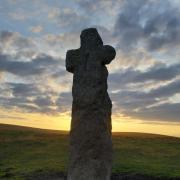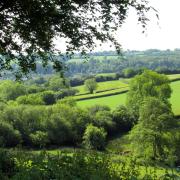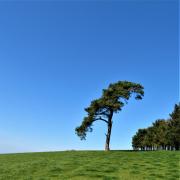Simone Stanbrook-Byrne, accompanied by Devon Life walks mascot, Bossington Bear take a stroll around Exminster marshes, exploring this wildlife-rich RSPB nature reserve, which was once part of the Exe Estuary before the Exeter Ship Canal 70 was built.
Not far from the city hubbub of Exeter, and close to the M5 and railway, is an area of land, the face of which has changed a good deal over time. Now an important wetland and wildlife conservation area, the RSPB’s Exminster Marshes Reserve was once part of the Exe Estuary, before the Exeter Ship Canal was built. This was all part of Exeter’s multi-faceted history as a port.

During medieval times the River Exe was tidal and navigable as far as the city, but in the 13th century the Countess of Devon built a weir across the river (hence Countess Wear in Exeter). This disruption to river traffic, and hence trade, was ongoing and controversial throughout the course of centuries. In the 16th century the first Exeter Canal was built to bypass the obstructions, engineered by John Trew of Glamorgan (hence Trew’s Weir, not far from the canal basin). It was the first canal to be built in Britain since the Romans left. This original canal was just 1¾ miles long, 16 feet wide and three feet deep, although it was later extended and improved.
The heyday of canals diminished as methods of transport changed, initially with the arrival of the railways. Canal traffic reduced over time, and now the waterway is enjoyed as a leisure facility. An interesting timeline of the canal can be found on the website of Friends of Exeter Ship Canal.
The canalside path is part of an easy circular walk around a lovely, wildlife-rich wetland, and the Exe Estuary as a whole is internationally renowned for birdlife. Relish it.
THE WALK
1. At the far end of the car park, near the wide gate, veer left to join a narrow footpath that soon passes through a smaller gate and enters the RSPB reserve, heading towards Turf Lock. The expanse of Exminster Marshes, with its extensive reed beds and scrubby trees, is to your left, the railway line up to your right. This is the main line between the West Country and London, the one that made national news a few years ago when violent weather and tides washed away the ballast, leaving the coastal section of line at Dawlish dangling in mid-air.
Follow this clear path passing occasional drainage channels, their waterside willows humming with insect life. Cattle conservation-graze the marsh at certain times of year, part of the good habitat management. Also look out for stretches of well-laid hedge alongside the path, a traditional form of management that keeps the hedge stockproof and enhances its wildlife value.

2. After about three-quarters of a mile an opening to the left of the path leads into a signed ‘discovery area’ where areas of specialist habitat have been created to attract a variety of wildlife, including grass snakes and slow worms. Paths lead to picnic benches, which offer somewhere to sit quietly, allowing the wildlife to come to you. Tread gently. When you’ve had enough of discovering continue along the path beside the railway. It soon bends left and arrives at a footbridge with an adjacent ‘viewing screen’, enabling wildlife watchers to scan an aqueous area of the marsh without being spotted themselves. Cross the footbridge and keep going along the path, which bends right in about 100m and arrives at a wooden-stepped stile.

3. Cross this and walk across the field aiming slightly right of the obvious building of The Turf Hotel. After wet weather this field can be extremely soggy, so if you’re not wearing wellies you might be glad you took note of the bit about spare socks. Our slithering provided a few minutes of entertainment for the cows. Negotiate the stile out of the field and cross the plank bridge towards The Turf, climbing a rising path to reach a three-way fingerpost. The nearby Turf Lock is the point at which the Exeter Ship Canal meets the Exe.
Unless you’re visiting the pub (or heading for Powderham or catching the ferry to Topsham – see ‘While you’re here’ panel), the walk now turns left, following the canalside path with the water and boats to your right. Beyond the canal the wider expanse of the estuary stretches across to Exton and Lympstone. This path alongside the canal is part of the Exe Valley Way and gives an elevated view across the nature reserve to the left.

4. In just over half-a-mile the path passes a parking area. Keep going for another half-mile to reach a white swingbridge, from which there’s a good view across the estuary to Topsham – another ferry runs from here, picturesquely hailed by hoisting a yellow buoy from the end of the swingbridge. By this bridge is a four-way fingerpost. Veer left here, away from the canal on a surfaced path (watch out for cyclists).

5. At this point there is a short diversion as the old footbridge that carried the footpath into the field has become unsafe. Follow the surfaced path for 130m, then go left through a metal gate and then turn immediately left again, back towards the unsafe footbridge. The expanse of the marsh is to you right; pass through a metal kissing gate and follow the water channel on your left, back to the bridge. Once you get there turn right, heading across the marsh towards a yellow-arrowed wooden footbridge. Cross this and continue on the same clear line across the marsh; small concrete bridges keep your feet dry through the mushier bits. This line eventually brings you to a crossing path with a wooden footbridge beyond that leads onto the surfaced lane. Turn right along it, ignore any turnings off and in a third-of-a-mile you arrive back at the entrance to the nature reserve’s car park.

COMPASS POINTS
Start point & parking: A car park to serve the nature reserve lies along the lane and across the railway bridge, beyond The Swan’s Nest and Toby’s Reclamation yard. Nearby postcode: EX6 8DZ; grid ref: SX953872
Map: OS Explorer Torquay & Dawlish, 1:25 000
Distance: Just under 4 miles
Terrain: Clear paths, which can be muddy after rain. If you’re not walking in wellies, take spare socks
Exertion: Very easy
Dog data: Animals grazing; dogs must be kept under control around the nature reserve
Refreshments: The Swan’s Nest, EX6 8DZ (01392 832371); The Turf Hotel (formerly Turf Locks), EX6 8EE (01392 833128)
While you’re here…. a few things to do:
Check individual websites for details
Powderham Castle is a couple of miles seaward along the estuary from The Turf. It is home to the Earls of Devon and offers a good variety of historic interest
Antique lovers may like to visit Toby’s Reclamation yard, not far from the reserve – an abundance of fascinating vintage collectibles and artefacts for home and garden
Dawlish Warren Nature Reserve juts out into the estuary and is a short road drive away. Nature watchers will need to negotiate the holiday resort area to reach the sand dunes of the reserve, but it’s worth the plunge!
Take a Ferry between Topsham and the Turf; it’s a good way to get on the water and Topsham is a great place to visit. Another ferry runs between the swingbridge and Topsham. Check their timetables to see when they are operating
Exeter’s Underground Passages fascinated me as a child and continue to do so today – take a walk through medieval Exeter’s underground world. The entrance is on Paris Street
Look out for:
Rich bird life, including Cetti’s Warbler
Wildflowers
Historic ship canal
Views across the Exe Estuary
Listen for a huge variety of bird calls
Walking 1000 miles: During 2023 Simone is walking 1000 miles to raise funds for the Devon Wildlife Trust. If you’d like to help support this charity and the Big Walk, please visit:
justgiving.com/page/simone-stanbrook-byrne-1678009505575



























